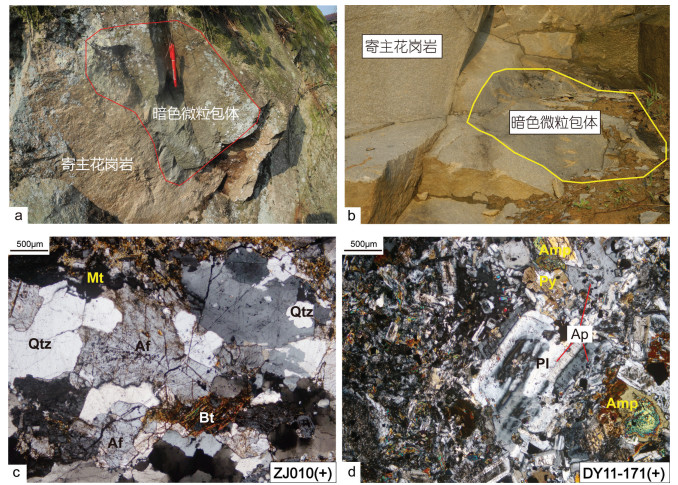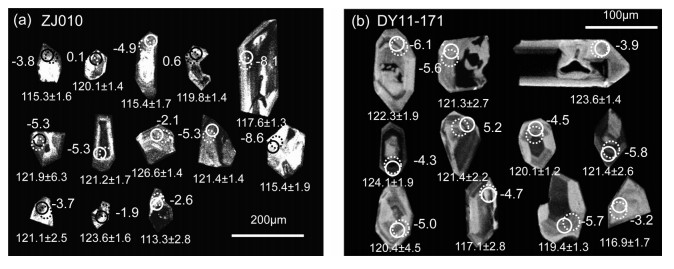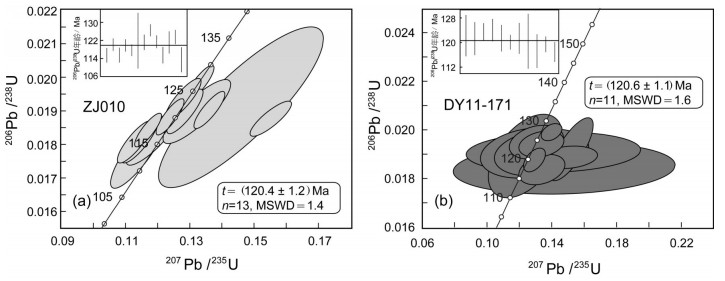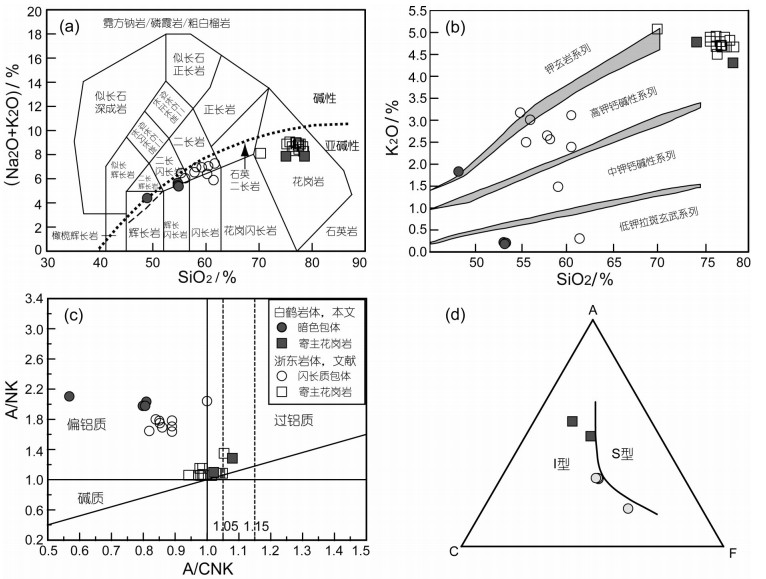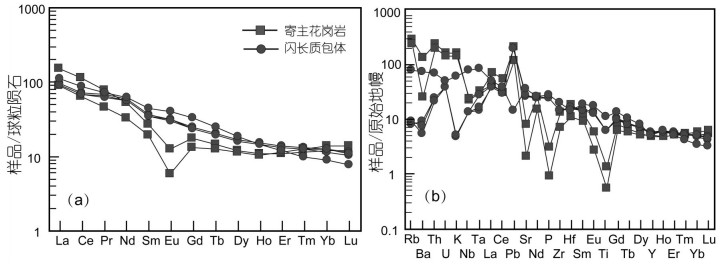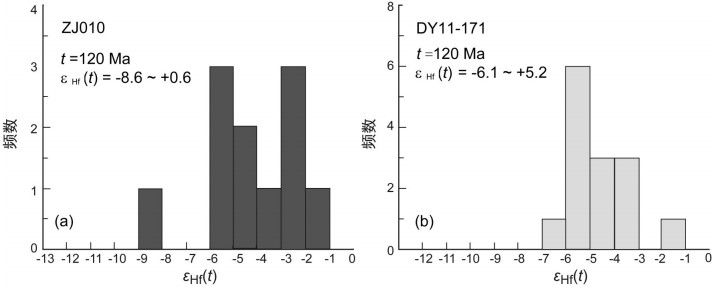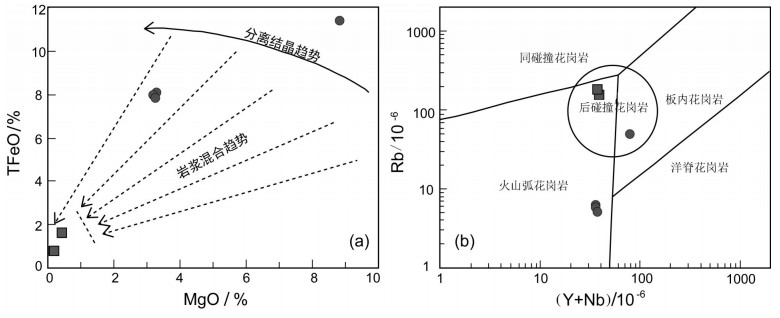Zircon U-Pb age, geochemistry and genesis of the Early Cretaceous mafic enclaves and granites in Tiantai area, eastern Zhejiang Province
-
摘要:
在华南东部浙闽沿海一带普遍发育有大量晚中生代花岗质岩体及其中的暗色包体,这些岩体被认为是大规模壳幔相互作用和岩浆混合作用的产物。本文对浙东天台地区白鹤岩体中的寄主花岗岩及其中发育的暗色包体分别进行了LA-ICP-MS锆石U-Pb定年和详细的岩石地球化学研究,其锆石U-Pb年龄分别为(120.4±1.2)Ma和(120.6±1.1)Ma,属浙东燕山期侵入活动集中的早白垩世中晚期产物。岩石地球化学特征显示,寄主花岗岩为高硅、富碱、弱过铝质的高钾钙碱性花岗岩,具有较强的Eu负异常,富集Rb、Th、U、K,并有Sr、Ba、P、Ti、Nb、Ta等元素的亏损,岩石成因为高分异I型花岗岩;暗色包体多为低硅、富钠、偏铝质低钾拉斑玄武系列岩石,轻稀土富集、重稀土亏损,并具有弱的Eu正异常。锆石Hf同位素组成表现出不同物质来源(壳幔混源)花岗岩类岩石的特点。综合年代学及岩石地球化学特征,认为浙东地区早白垩世I型花岗岩及其暗色包体是在燕山期弧后碰撞伸展引张的构造背景下,由底侵的幔源岩浆与其诱发熔融的深部壳源岩浆经混合后,经过一定程度的分异演化,最后定位于浅成环境的产物。
Abstract:A large number of Late Mesozoic granitic plutons with dark enclaves are widespread in the coastal area of Zhejiang and Fujian Province. They are considered to be the product of large-scale crust mantle interaction and magma mixing. In this paper, the authors conducted the LA-ICP-MS U-Pb dating and obtained whole-rock geochemical data of the host granites and dark enclaves of Baihe intrusion in Tiantai area, eastern Zhejiang Province, with the purpose of exploring the geochronology, petrogenesis and tectonic implications. The results obtained show that the U-Pb zircon ages of the host granite and dark enclaves are(120.4±1.2) Ma and(120.6±1.1) Ma, respectively. They are products of the Early Cretaceous Yanshanian intrusive activities in eastern Zhejiang in a syncollisional-postcollisional environment. Geochemical analyses show that the host rocks are high-potassium calc-alkaline Itype granite, with enriched SiO2, total alkalis, and weakly-peraluminous nature; they are enriched in Rb, Th, U and K, and depleted in Sr, Ba, P, Ti, Nb and Ta, with strong negative Eu anomaly. The dark enclaves belong chemically to partial alumina low-potassium tholeiite series, with lower SiO2, enriched sodium, enriched LREE, relatively depleted HREE, and weak positive Eu anomaly. The Hf isotope composition of zircons from host granite and dark enclaves are all indicative of mixing of crustal and mantle materials. Based on the geochronological and geochemical data, the authors hold that the Early Cretaceous I-type granites and their dark enclaves in eastern Zhejiang were generated by mixing of mantle-derived basic magma and its induced crustal felsic magma in an extension environment which followed the Yanshanian arc-back collision.
-
1. 引言
祁连山位于华北板块西南缘,与秦岭、昆仑一起构成中国大陆内部巨型的中央造山带,是中国大陆主要造山带之一。北祁连造山带雄踞于河西走廊之南,成为青藏高原的东北界,东南与西秦岭相连,西北被阿尔金山截断(葛肖虹等,1999;杨永春等,2019;图 1a)。前人通过大量岩石学、沉积等研究对北祁连洋盆的俯冲极向做过研究,主要形成了双向俯冲(肖序常等,1978;王荃等,1981;左国朝等,1987;吴才来等,2010)、向北俯冲(许志琴等,1994;夏林圻等, 1996, 1998;张建新等, 1997, 1998;夏林圻等,2016)、向南俯冲(宋述光,1997;刘传周等,2005),目前尚无统一的认识。已有研究表明,通过花岗岩类地球化学特征及同位素年代学的研究可以提供有关其形成的大地构造背景信息,可以作为地质构造示踪剂(徐卫东等,2007;秦海鹏,2012)。目前,在北祁连山造山带毛藏寺、银硐梁、大野口等多处发现有埃达克岩或埃达克质岩石,这类岩石为区域构造背景研究提供了依据,本文试图利用车路沟岩体对北祁连构造演化进行研究。
研究区位于北祁连造山带西段,区内广泛发育寒武系黑茨沟组裂谷火山岩(王晓伟等,2018)、奥陶系阴沟群和扣门子组岛弧-弧后扩张脊型火山岩以及志留系复理石沉积,分布有俯冲混杂岩带,具有典型的沟弧盆体系(夏林圻等,2001),车路沟岩体位于前人所划分的奥陶系岛弧火山岩-沉积岩系中。前人对岩体特征和时代做了一些研究(杨建国等,2003;宋忠宝等,2004;贾群子等,2005),但多围绕其与金成矿作用方面的研究,宋忠宝等(2005)通过对车路沟中英安斑岩进行年代学、地球化学研究,认为车路沟岩体属于碰撞型花岗岩类,形成于碰撞作用晚期。本文通过对车路沟岩体中英云闪长玢岩的岩石学、地球化学、锆石U-Pb年代学等方面的研究,分析其岩石成因,揭示其形成时的构造背景,为北祁连造山带构造演化提供约束。
2. 区域地质概况
研究区大地构造位置属北祁连早古生代造山带西段之西端(杨建国等,2003),距离北祁连造山带与阿尔金断裂交汇部位4 km。区域上地层北部有古元古界敦煌岩群零星分布外,以古生界为主,主要有寒武系、奥陶系、志留系,其次为石炭系。区域上侵入岩较为发育,以明芨芨沟岩体、青石峡岩体、青山岩体和车路沟岩体为主,分布范围较大,多呈岩株状分布,展布方向和区域构造线方向基本一致,多呈北西、北西西向。
车路沟岩体位于北祁连造山带西段,紧邻阿尔金走滑断裂南侧,出露面积较大(图 1b),自阴凹大泉至照壁山一带广泛分布,多侵入于奥陶系扣门子组中,岩体被断裂构造破坏严重,形态呈不规则块状,呈岩基状东西向条带状分布,边界明显的受控于断裂构造(夏林圻等,2001),多与地层呈断层接触,接触部位具明显的片理化,反映岩体的形成与板块俯冲、碰撞和造山带上不同的块体之间的构造作用密切相关(吴才来等,2010)。
![]() 图 1 车路沟一带地质简图1—第四系冲、洪积物;2—二叠系砂岩;3—石炭系砂岩;4—志留系复理石建造;5—奥陶系扣门子组火山岩系;6—奥陶系中堡群火山-碎屑岩系;7—奥陶系阴沟群火山岩系;8—石英二长闪长岩;9—英云闪长玢岩;10—闪长玢岩;11—实测断裂构造;12—同位素测年样品采样位置;13—岩石全分析样品采样位置Figure 1. Regional geological map of the Chelugou pluton1- Quaternary; 2- Permian sandstone; 3- Carboniferous sandstone; 4- Silurian flysch formation; 5- Volcanic rocks of Ordovician Koumenzi Formation; 6- Volcanic clastic rocks of Ordovician Zhongbu Group; 7- Volcanic rocks of Ordovician Yingou Group; 8- Quartz monzodiorite; 9- Quartz mica dioritic porphyry; 10-Diorite porphyry; 11-Fault; 12-Sampling position for isotope dating; 13- Sampling position for rock analysis
图 1 车路沟一带地质简图1—第四系冲、洪积物;2—二叠系砂岩;3—石炭系砂岩;4—志留系复理石建造;5—奥陶系扣门子组火山岩系;6—奥陶系中堡群火山-碎屑岩系;7—奥陶系阴沟群火山岩系;8—石英二长闪长岩;9—英云闪长玢岩;10—闪长玢岩;11—实测断裂构造;12—同位素测年样品采样位置;13—岩石全分析样品采样位置Figure 1. Regional geological map of the Chelugou pluton1- Quaternary; 2- Permian sandstone; 3- Carboniferous sandstone; 4- Silurian flysch formation; 5- Volcanic rocks of Ordovician Koumenzi Formation; 6- Volcanic clastic rocks of Ordovician Zhongbu Group; 7- Volcanic rocks of Ordovician Yingou Group; 8- Quartz monzodiorite; 9- Quartz mica dioritic porphyry; 10-Diorite porphyry; 11-Fault; 12-Sampling position for isotope dating; 13- Sampling position for rock analysis3. 岩石学特征
车路沟岩体主要由英云闪长玢岩、闪长玢岩组成,局部为石英闪长玢岩、英云闪长岩等,岩体与地层接触部位产出车路沟金矿、昌马金矿等多个金矿床。主要岩石特征如下:
英云闪长玢岩,灰白色,斑状结构,基质微粒花岗结构,块状构造。斑晶主要是斜长石和角闪石(10%~15%),粒径0.25~1.90 mm。斜长石为自形—半自形晶板条状,角闪石多为长柱状,斜长石具高岭土化、绿帘石化。基质成分由长石、角闪石、石英和不透明矿物组成,粒径小于0.10 mm(图 2a,b)。
闪长玢岩,浅灰黑色,斑状结构,显微粒状半自形柱状粒状结构,块状构造。斑晶为角闪石及少量斜长石,大小一般1~5 mm,星散状分布,含量15%~20%。基质为斜长石、石英、角闪石,大小一般0.1~0.2 mm,少0.02~0.1 mm(细),部分0.2~0.3 mm(细),杂乱分布。具绢云母化、绿帘石化、碳酸盐化(图 2c,d)。
4. 样品采集及分析方法
本次工作分别在岩体的不同地方采集了4件新鲜的岩石样品,做了岩石地球化学全分析,所采岩石类型均为英云闪长玢岩,样品重量均大于2 kg,利用玛瑙球磨机研磨至200目进行分析,样品加工由河北省区域地质调查研究所实验室承担,样品的加工过程均是在无污染设备中进行。在岩体西部二家台一带采集了新鲜英云闪长玢岩岩石样品1件,样品重量为11.3 kg,以挑选锆石进行U-Pb同位素测年。
锆石分选、制靶、透反射光拍照和阴极发光拍照均在廊坊诚信地质服务有限公司完成。锆石的激光剥蚀电感耦合等离子体质谱(LA-ICP-MS)原位U-Pb定年在中国地质调查局西安地质调查中心自然资源部岩浆作用成矿与找矿重点实验室完成。激光剥蚀系统为GeoLas Pro,ICP-MS为Agilent 7700x。激光剥蚀过程中采用氦气作载气、氩气为补偿气以调节灵敏度。对分析数据的离线处理(包括对样品和空白信号的选择、仪器灵敏度漂移校正、元素含量及U-Th-Pb同位素比值和年龄计算)采用软件Glitter 4.4完成,详细仪器参数和测试过程参见李艳广等(2015)。采用锆石标准91500作为标样进行同位素分馏校正。对于与分析时间有关的U-Th-Pb同位素比值漂移,利用91500的变化采用线性内插的方式进行了校正。锆石样品的U-Pb年龄谐和图绘制和年龄权重平均计算均采用Isoplot Exver 3完成。
5. 分析结果
5.1 地球化学特征
从表 1可知,岩石中SiO2含量60.37% ~66.73%,平均63.75%,Al2O3含量15.65%~16.45%,平均16.01%,Na2O/K2O值7.47~9.96,平均8.38,Na2O高于K2O数倍,P2O5含量SiO2呈反比,与表明其源于贫钾的玄武质岩石(张旗等,2002),为I型花岗岩,里特曼指数(σ43)1.28~2.22,为低钾富钠钙碱性花岗岩,A/CNK为0.90~1.00,平均0.93,为准铝质,且经CIPW标准矿物计算出现刚玉,说明具有活动大陆边缘环境I-S过渡型花岗岩的特征(秦海鹏,2012)。MgO含量1.78~3.95,平均2.63;分异指数DI大于59.55,分异程度中等略高。
表 1 车路沟岩体主量元素(%)、微量元素(10-6)分析结果Table 1. Analytical results of major elements (%) and trace elements (10-6) of the Chelugou rock mass
从微量元素原始地幔标准化蛛网图中可以看出(图 3、表 1),大离子亲石元素(LILE)富集Ba、Sr、Hf,高场强元素(HFSE)明显贫Nb、Ti、Yb,相对富集Zr。稀土总量33.40×10-6~39.27×10-6,平均35.99×10-6,远低于中性岩稀土总量196×10-6和花岗岩稀土总量290×10-6。LREE/HREE值3.95~6.51,轻稀土元素较富集,HREE含量较低,平均6.01×10-6,Y含量7.46×10-6~13.44×10-6,Yb含量0.58×10-6~1.36×10-6,(La/Yb)N值2.87~6.29(表 1),稀土元素球粒陨石标准化分配曲线为右倾型(图 3),轻、重稀土元素分异明显,δEu值1.23~1.49,Eu呈正异常,说明岩浆源区无残留斜长石。稀土元素特征与埃达克岩亏损重稀土、低Y、Yb及正铕异常的特征相符(Defant et al., 1990)。
5.2 U-Pb年代学特征
锆石多呈长柱状或菱形柱体,为典型的锆石晶体形状,多呈自形、半截状,锆石具有明显的震荡环带,部分锆石内部有继承核存在,生长纹路清晰,为典型的岩浆锆石(图 4),本次利用LA ICP-MS对锆石进行了测试,锆石Th/U比值0.07~1.73,平均0.57,具岩浆锆石的特征(表 2)。测试结果中,共有12个测试点具有谐和年龄,表面年龄分为2组(图 5),第一组有5个点,表面年龄406.2~422.9 Ma,获得加权平均年龄(416.6±9.5)M a,MSWD =1.7;第二组有7个点,表面年龄457.7~465 Ma,获得加权平均年龄(462.1±3.8)Ma,MSWD=0.15。第二组年龄应是岩浆侵位结晶年龄,第一组年龄可能反映了后期的岩浆热事件。
表 2 车路沟岩体中LA ICP-MS锆石U-Pb同位素测年结果Table 2. Zircon LA ICP-MS U-Pb isotopic data of the Chelugou pluton
5.3 年代学讨论
宋忠宝等(2005)在车路沟岩体中采集英安斑岩同位素样品进行了U-Pb同位素年龄为(427.7±4.5)Ma,本次工作在开展区内地质调查过程中,结合薄片鉴定认为,前人所认为的英安斑岩即为车路沟岩体中的闪长玢岩,贾群子等(2007)在岩体西部二家台沟采集英云闪长玢岩进行了单颗粒锆石U-Pb年龄测定,获得加权平均年龄为(445.6±3.2)Ma,认为该年龄是锆石的结晶年龄,接近岩体的形成年龄。
结合前人测试结果,笔者认为车路沟岩体可能为复式岩体或者岩浆演化经历了较长的时间,岩体中两种岩性整体为同源岩浆演化,岩体演化早期阶段为英云闪长玢岩为主,伴随有中酸性—中性岩浆的分异,后期演化为闪长玢岩。因此,该岩体就位时间为(462.1±3.8)Ma,为中奥陶世。
6. 讨论
埃达克岩是一套具有特定地球化学特征的钙碱性中酸性喷出/侵入岩(Defant et al., 1990),具有高SiO2(≥56%)、高铝(Al2O3≥15%)、富钠(Na2O>K2O)、高Sr(>400×10-6)、低Y(<18×10-6)和Yb(<1.9×10-6)以及不明显的Eu异常等地球化学特征。车路沟岩体SiO2含量为60.37% ~66.31%,Al2O3含量15.72%~16.45%,Na2O含量4.86%~6.19%,K2O含量0.62%~0.72%,Na2O/K2O为7.47~9.96,Sr含量299.52×10-6~525.85×10-6,Y含量7.46×10-6~13.44×10-6,Yb含量0.58×10-6~1.36×10-6,Sr/Y值为30.90~70.48。该岩体轻稀土富集,轻重稀土分馏明显,亏损高场强元素,同时在Y-Sr/Y图解中(图 6a)全部落入埃达克岩区域。上述特征表明,车路沟岩体与典型埃达克岩的特征一致(Defant et al., 1990, 2002;毛启贵等, 2010;Zheng et al., 2018)。
埃达克岩最早被认为是由于年轻的俯冲大洋板片在榴辉岩相下熔融形成火山岩和侵入岩(Defant et al., 1990),随着研究的深入,越来越多与埃达克岩相似地球化学属性的岩石被发现。目前对埃达克岩的成因模式主要有以下4种:(1)俯冲洋壳的部分熔融,随后与上覆楔形地幔橄榄岩发生反应形成埃达克岩(Defant et al., 1990, 2002;Kay,1993;Martin et al., 2005;Wang et al., 2007, 2008a;Tang et al., 2010;毛启贵等, 2010;Zheng et al., 2018);(2)含水玄武质岩浆高/低压条件下发生结晶分异作用(Castillo et al., 1999, 2012;Macpherson et al., 2006);(3)受玄武质岩浆底侵作用或俯冲大陆地壳发生部分熔融产物(Wang et al., 2008b;Lai et al., 2013);(4)增厚下地壳拆沉作用导致部分熔融产生的流体和地幔橄榄岩相互作用形成的高Mg#埃达克岩(Rudnick et al., 1995;Wareham et al., 1997;Chung et al., 2003;Gao et al., 2004;Wang et al., 2006;朱涛等,2014;王楠等,2016)。
车路沟岩体岩石地球化学研究表明,K2O含量0.62%~0.72%,Na2O/K2O值7.47~9.96,与洋壳特征相似,其岩石类型为富Na2O的钙碱性岩浆,这与俯冲洋壳熔融形成的埃达克岩一致(Defant et al., 2002)。岩体具较高的Cr(27.30 × 10-6~70.79 × 10-6)、Ni(27.01×10-6~46.65×10-6)及Mg#值(52.24~59.79),应该是板片俯冲熔融产生的埃达克岩浆与地幔楔相互作用导致MgO加入的结果。车路沟岩体以较低的Nb(1.92×10-6~2.15×10-6)含量与洋岛玄武岩(>20×10-6)Nb值存在明显的差异,反映其并非含水玄武质岩浆结晶分异而成。俯冲大陆地壳发生部分熔融产生的埃达克岩,具有明显的富钾特征(K2O>Na2O),较高的Th含量、Th/U、Th/Ba和Rb/Ba比值,以及Sr的弱异常。车路沟岩体具富钠特征(Na2O>K2O),具有较低的Th含量(0.68 × 10-6~1.57×10-6),以及较低的Th/Ba(0.001~0.004)和Rb/Ba(0.02~0.04)比值和较高的Sr含量(299.52 ×10-6~525.85×10-6),可与俯冲大陆地壳发生部分熔融产生的埃达克岩相区别。拆沉下地壳熔融产生的埃达克岩浆在上升过程中与地幔橄榄岩发生反应从而获得较高的Mg#,拆沉下地壳来源的埃达克岩通常含有壳源继承锆石,而本次研究中锆石结构均一,没有继承性锆石。因此,车路沟岩体应为俯冲洋壳熔融形成的埃达克岩,而非其他成因的埃达克岩。
地球化学特征表明车路沟岩体源于贫钾的玄武质岩石,通过A/MF-C/MF图解对岩浆成因进行了判别,所有数据均落入基性岩的部分熔融(图 6b),推测岩浆来源与新生基性火山岩的部分熔融有关(Zhang et al., 2017),这一点,在野外地质分布特征中也可以分辨,岩体大部分侵入于奥陶系扣门子组弧后扩张型火山岩中,但未见到志留纪复理石建造中有侵入特征,说明其形成与俯冲作用有关。车路沟岩体δEu变化范围为1.10~1.49,平均1.285,表明在岩浆分离结晶过程中斜长石不占据元素总分配系数的主导地位,岩浆中应残留石榴子石或者角闪石。前人研究认为,岩浆源区中以角闪石为残留相时,形成的熔体具轻微上凹的HREE配分模式,且Y/Yb比值一般接近10;当源区中以石榴子石为残留相时,形成的熔体具有倾斜的HREE配分模式同时其Y/Yb比值明显大于10(Rollinson, 1993; 高永丰等,2003)。车路沟岩体Y/Yb比值为9.91~12.90,平均为11.34,稀土配分模式显示(图 3),其为基本向右倾斜的HREE配分模式,表明岩浆岩区残留相以石榴子石为主,由此推测车路沟埃达克岩体来源于基性玄武质岩浆的部分熔融。
在(Y+Nb)-Rb和Y-Nb构造判别图上(图 7),车路沟岩体分别落入火山弧花岗岩(VAG)和火山弧+同碰撞花岗岩(VAG+Sny+COLG)区域内,反映出与火山弧花岗岩的亲缘性。同时,岩体Nb、Ti的负异常其形成于俯冲背景下,Cr、Ni正异常代表有地幔物质的参与。由此推测,车路沟岩体可能是俯冲板片流体交代地幔楔诱发地壳富含石榴石相的基性玄武岩质岩石部分熔融,并在上升过程中混染了火山弧物质所形成的埃达克岩。
区域构造研究表明,北祁连从古元古代中期开始,大陆岩石圈拉伸、减薄,并发生裂谷化(左国朝等,1987;夏林圻等, 1996, 2000;葛肖虹等,1999); 至新元古代,裂谷作用进一步加强,发育以双峰式火山岩为特征的大陆裂谷火山作用;到晚寒武世,最终发生大陆裂解和分离,形成北祁连早古生代洋盆,于奥陶纪北祁连洋盆进入俯冲消减和弧后盆地协同演化阶段,发育大量岛弧和弧后盆地火山岩(左国朝等,1987;夏林圻等, 1991, 1996;葛肖虹等,1999;张旗等,2000;Xia et al., 2003;曾建元等,2007;夏小洪等,2010;Song et al., 2013),至445~424 Ma,洋盆闭合进入陆内碰撞和深俯冲过程(Xia et al., 2003;吴才来等,2006;Zhang et al., 2007)。夏林圻等认为,北祁连加里东造山带是在前寒武纪基底之上发生拉张(679~574 Ma), 至寒武纪末期到早奥陶世(522~495 Ma)形成洋盆,奥陶纪(469~445 Ma)自南西向北东往华北大陆板块之下俯冲,大洋板块持续俯冲致使洋盆闭合(445~428 Ma)。
前人在北祁连造山带中段毛藏寺、北祁连东段银硐梁、北祁连走廊南山北坡大野口均发现了埃达克岩,上述埃达克岩体同位素年龄集中在446~455.8 Ma,均为北祁连早古生代沟弧盆构造环境的产物(王金荣等,2006;赵辛敏等,2018;唐卓等,2018)。本文获得的车路沟岩体的结晶年龄为(462.1±3.8)Ma,与前人研究认为祁连洋向北俯冲的时间吻合,说明车路沟岩体是在奥陶纪祁连洋自南西往北东持续向华北板块之下俯冲过程中形成的。
如前文所述,车路沟岩体具埃达克岩特征,是奥陶纪时期与祁连洋持续向华北板块俯冲作用有关的俯冲洋壳部分熔融和壳幔岩浆混合成因的花岗岩。
7. 结论
(1)车路沟岩体为准铝质低钾钙碱性系列,具有富硅、富铝、富钠、高Mg#、高Sr、高Sr/Y和低HREE、低Y、低Yb的特征,具典型埃达克岩的地球化学特征。
(2)车路沟岩体中英云闪长玢岩的锆石LA -ICP-MS U-Pb测年结果表明,其结晶年龄为(462.1±3.8)Ma,属中奥陶世。
(3)根据岩石学、岩石地球化学研究,结合前人区域构造研究成果,推测车路沟岩体为奥陶纪祁连洋持续向华北板块俯冲,诱使俯冲洋壳部分熔融形成的埃达克岩。
致谢: 两位审稿专家为论文的完善提出的宝贵意见和建设性建议;锆石LA-ICP-MS U-Pb年龄及Hf同位素分析得到了中国地质科学院矿产资源研究所MC-ICP-MS实验室侯可军和郭春丽两位博士的大力支持,在此一并表示感谢。 -
图 1 浙江天台白鹤岩体地质简图
a—浙江省早白垩世岩体分布图;b—白鹤岩体地质简图(据浙江省区域地质大队,1973➊修改)图中DY11-171, 172, 173和ZJ009, 010, 011为6个样品采样位置
Figure 1. Simplified geological map of the Baihe pluton in Tiantai, Zhejiang Province
a-Distribution of Early Cretaceous plutons in Zhejiang Province, ; b-Simplified geological map of the Baihe pluton (aftert Regional Geological Team of Zhejiang Province, 1973➊). DY11-171, 172, 173 and ZJ009, 010, 011 refer to the 6 samples and locations
图 2 白鹤岩体中暗色微粒包体野外照片(a, b)及寄主岩与包体典型岩相学显微照片(c, d)
Q—石英; Af—碱性长石; Pl—斜长石; Amp—角闪石; Py—辉石; Ap—磷灰石; Bt—黑云母; Mt—磁铁矿
Figure 2. Field photos of dark microgranular enclaves in Baihe pluton (a, b) and microphotographs of K-feldspar granite (host rocks) and enclaves (c, d)
Q-Quartz; Af-Alkali-feldspar; Pl-Plagioclase; Amp-Amphibole; Py-Pyroxene; Ap-Apatite; Bt-Biotite; Mt-Magnetite
图 5 浙东花岗质岩体主量元素成分图
a—硅-碱图(底图据Middlemost, 1994); b—钾-碱图(底图据Rickwood, 1989); c—A/CNK-A/NK图(底图据Maniar et al., 1989); d—花岗岩ACF图解(文献数据谢磊等, 2004; 张晓琳等, 2005; 董传万等, 2008; 王对兴等, 2013)
Figure 5. Plots of major element compositions of granitic rocks from eastern Zhejiang Province
a-Diagram of total alkali versus silica (after Middlemost, 1994); b- Diagram of potassium versus silica (after Rickwood, 1989); c-Diagram of A/NK versus A/CNK (after Maniar et al., 1989); d-ACF diagram of granites (Referential data after Xie Lei et al., 2004; Zhang Xiaolin et al., 2005; Dong Chuanwan et al., 2008; Wang Duixing et al., 2013)
图 6 浙江天台白鹤岩体稀土元素球粒陨石配分型式及微量元原始地幔标准化蛛网图
(a, 球粒陨石标准化值据Boynton, 1984; b, 原始地幔标准化值据Sun et al., 1989)
Figure 6. Chondrite-normalized REE patterns and primitive mantle-normalized trace element spidergrams of the Baihe pluton in Tiantai, Zhejiang Province
(a, chondrite normalized values after Boynton, 1984; b, primitive mantle normalized values after Sun et al., 1989)
图 8 浙江天台白鹤岩体MgO-TFeO图解(a底图据Zorpi et al., 1991)和(Y+Nb)-Rb图解(b底图据Pearce et al., 1984)(图例同前)
Figure 8. The diagrams of MgO versus TFeO (a after Zorpi et al., 1991) and w(Y+Nb) versus w(Rb) (b after Pearce et al., 1984)from Baihe pluto in Tiantai, Zhejiang Province
表 1 浙江天台白鹤岩体主量(%)及微量(10-6)元素分析结果
Table 1 Abundances of major (%) and trace(10-6)elements in Baihe pluton in Tiantai, Zhejiang Province

表 2 浙江天台白鹤岩体钾长花岗岩寄主岩及暗色闪长质包体的锆石U-Th-Pb同位素测定结果
Table 2 Zircon U-Th-Pb dating results for the host granite and diorite enclaves of Baihe pluton in Tiantai, Zhejiang Province

表 3 浙江天台白鹤岩体的锆石Hf同位素数据
Table 3 Hf isotopic data of zircons from the granitoid samples of Baihe pluton in Tiantai, Zhejiang Province

-
Albarède F. 1998. The growth of continental crust[J]. Tectonophysics, 296(1):1-14. http://cn.bing.com/academic/profile?id=abcbf289b59cbb8192f6024293dcd3d6&encoded=0&v=paper_preview&mkt=zh-cn
Andersen T, Griffin W L, Sylvester A G. 2007. Sveconorwegian crustal underplating in southwestern Fennoscandia:LA-ICP-MS U-Pb and Lu-Hf isotope evidence from granites and gneisses in Telemark, southern Norway[J]. Lithos, 93(3):273-287. http://cn.bing.com/academic/profile?id=fe0dcb469ebb2e30d379a73b63850041&encoded=0&v=paper_preview&mkt=zh-cn
Barbarin B. 1999. A review of the relationships between granitoid types, their origins and their geodynamic environments[J]. Lithos, 46:605-626. http://cn.bing.com/academic/profile?id=0327fb49d0027fd8c3b6d015120958d7&encoded=0&v=paper_preview&mkt=zh-cn
Belousova E A, Griffin W L, O'reilly S Y. 2006. Zircon crystal morphology, trace element signatures and Hf isotope composition as a tool for petrogenetic modelling:Examples from Eastern Australian granitoids[J]. Journal of Petrology, 47(2):329-353. http://cn.bing.com/academic/profile?id=b658f0c9642099f92f83e3ca9062b2e5&encoded=0&v=paper_preview&mkt=zh-cn
Blake S, Fink J H. 2000. On the deformation and freezing of enclaves during magma mixing[J]. Journal of Volcanology and Geothermal Research, 95:1-8. http://cn.bing.com/academic/profile?id=de85056117cd12eb27a83a96c43ef0a7&encoded=0&v=paper_preview&mkt=zh-cn
Boynton W V. 1984. Geochemistry of the rare earth elements:meteorite studies. Henderson P, Rare Earth Elements Geochemistry[J]. Amsterdam:Elservier:63-144. http://cn.bing.com/academic/profile?id=a86bc72c95d06bcdf62c0e1eb55bf851&encoded=0&v=paper_preview&mkt=zh-cn
Browne B L, Eichelberger J C and Patino L C. 2006. Generation of porphyritic and equigranular mafic enclaves during magma recharge events at Unzen volcano, Japan[J]. Journal of Petrology, 47(2):301-328. http://www.wanfangdata.com.cn/details/detail.do?_type=perio&id=4d8c96635e073637b66331b8f9ba59e8
Chappell B W, White A J R.1974. Two contrasting granite types[J]. Pacific Geology, 8(2):173-174. http://cn.bing.com/academic/profile?id=b3cb78774c04d449c409c58967abf9e3&encoded=0&v=paper_preview&mkt=zh-cn
Chappell B W, White A J R.1992.I- and S-type granites in the Lachlan Fold Belt[J]. Geological Society of America Special Papers, 272:1-26. http://cn.bing.com/academic/profile?id=6f03caf823d3c86871acbbe1254988a2&encoded=0&v=paper_preview&mkt=zh-cn
Chappell B W. 1999. Aluminium saturation in I- and S-type granites and the characterization of fractionated haplogranites[J]. Lithos, 46(3):535-551. http://cn.bing.com/academic/profile?id=d4aaafb0efa17793757fedb0eee8e30c&encoded=0&v=paper_preview&mkt=zh-cn
Chen Jiangfeng, Zhou Taixi, Yin Chunsheng, Foland K A. 1991.40Ar-39Ar age of some Mesozoic intrusive rocks in the southeast of Zhejiang Province[J]. Acta Petrologica Sinica, 7(3):37-44 (in Chinese with English abstract). http://cn.bing.com/academic/profile?id=7517fdd0bff6ebcd3515a1ea377e4f73&encoded=0&v=paper_preview&mkt=zh-cn
Chen Rong, Zhou Jincheng. 1999. Information of crust-mantle interaction implied in Early Cretaceous composite lavas and dikes from eastern Zhejiang[J]. Geological Review, 45(supp.):784-795(in Chinese with English abstract).
Chen Rong, Xing Guangfu, Yang Zhuliang, Shen Jialin, Zhou Yuzhang. 2005. Study on Beizhang and Lianglong granites and their dark enclaves[J]. Geological Journal of China Universities, 11 (2):264-275(in Chinese with English abstract). http://www.wanfangdata.com.cn/details/detail.do?_type=perio&id=gxdzxb200502015
Chen Xijie, Zhang Kuihua, Zhou Jian. 2016. Geochronology and geochemistry characteristics of the Early Permian monzogranite and dioritic enclaves of East Tianshan and their tectonic implications[J]. Acta Geologica Sinica, 90(9):2334-2354(in Chinese with English abstract). http://www.wanfangdata.com.cn/details/detail.do?_type=perio&id=dizhixb201609015
Clemens J D. 2003. S-type granitic magmas-petrogenetic issues, models and evidence[J]. Earth Science Review, 61:1-18. http://www.wanfangdata.com.cn/details/detail.do?_type=perio&id=03161a81c198c5105df838f42f63f2cf
Collins W J, Beams S D, White A J R, Chappell B W. 1982. Nature and origin of A-type granites with particular reference to southeastern Australia[J]. Contributions to Mineralogy and Petrology, 80(2):189-200. http://cn.bing.com/academic/profile?id=f13896b7c8e2bd81d8fb90bd9bb509db&encoded=0&v=paper_preview&mkt=zh-cn
Cui Jiawei, Zheng Youye, Sun Xiang, Wu Shun, Gao Shunbao, Tian Liming, Sun Junyi, Yangchao. 2016. Origin of granodiorite and mafic microgranular enclave in Saizhisi, Qinghai Province:Zircon U-Pb geochronological, geochemical and Sr-Nd-Hf isotopic constraints[J]. Earth Science, (7):1156-1170(in Chinese with English abstract).
Dong Chuanwan, Peng Yaming. 1994. Qingtian composite body-the coexisting of two different types of granites[J]. Journal of Zhejiang University(Natural Science), 28(4):440-448(in Chinese with English abstract). http://en.cnki.com.cn/Article_en/CJFDTotal-ZDZC404.010.htm
Dong Chuanwan, Xu Xisheng, Yan Qiang, Lin Xiubin, Zhu Guoqiang. 2007. A new case of Late Mesozoic crust-mantle interaction in eastern Zhejiang:Geochronology and geochemistry of the Ru'ao diabase-granite composite intrusions[J]. Acta Petrologica Sinica, 23(6):1303-1312(in Chinese with English abstract).
Dong Chuanwan, Yang Shufeng, Tang Limei, Du Zhenyong. 2008.Petrology and geochemistry of the Xinchang composite igneous complexes, Zhejiang and their geological implication[J]. Geological Journal of China Universities, 14(3):365-376(in Chinese with English abstract). http://www.wanfangdata.com.cn/details/detail.do?_type=perio&id=gxdzxb200803007
Dong Chuanwan, Shen Zhongyue, Du Zhenyong, Yang Yongfeng, Gu Hongyan. 2009. A new case of Late Mesozoic magma mixing in eastern Zhejiang:Discovery of the Ruao enclave swarms, Xinchang County and its geological implication[J]. Journal of Zhejiang University(Science Edition), 36(2):224-230(in Chinese with English abstract). http://cn.bing.com/academic/profile?id=981d6bc884438192556d4d57f69a194e&encoded=0&v=paper_preview&mkt=zh-cn
Esna-Ashari A, Hassanzadeh J, Valizadeh M V. 2011. Geochemistry of microgranular enclaves in Aligoodarz Jurassic arc pluton, western Iran:Implications for enclave generation by rapid crystallization of cogenetic granitoid magma[J]. Mineralogy and Petrology, 101(3/4):195-216. http://cn.bing.com/academic/profile?id=49d19500066be2152f13e57a0aac7d84&encoded=0&v=paper_preview&mkt=zh-cn
Ferla P, Melic. 2006. Evidence of magma mixing in the "Daly Gap" of alkaline suites:A case study from the enclaves of Pantelleria(Italy)[J]. Journal of Petrology, 47(8):1467-1507. http://cn.bing.com/academic/profile?id=ccd9ec63c9dc89aebf88ec6fa40e548c&encoded=0&v=paper_preview&mkt=zh-cn
Fernandez A N, Barbarin B. 1991. Relative rheology of coeval mafic and felsic magmas: nature of resulting interaction processes and shape and mineral fabrics of mafic microgranular enclaves[C]//Didier J, Barbarin B (eds.). Enclaves and Granite Petrology.Amsterdam: Elsevier: 263-276.
Frost C D, Frost B R. 2011. On ferroan (A-type) granitoids:their compositional variability and modes of origin[J]. Journal of Petrology, 52(1):39-53. http://cn.bing.com/academic/profile?id=eed8a85a666596c17c0a7b9ed3b8bf84&encoded=0&v=paper_preview&mkt=zh-cn
Gao Shan, Luo Tingchuan, Zhang Benren, Zhang Hongfei, Han Yinwen, Zhao Zhidan. 1999. The structure and composition of the crust in eastern China[J]. Science in China(Series D), 29(3):204-213(in Chinese). http://cn.bing.com/academic/profile?id=d15e52a5c6b61ca4f080f39a3c025176&encoded=0&v=paper_preview&mkt=zh-cn
Griffin W L, Belousova E A, Shee S R, Pearson N J, O'reilly S Y. 2004. Archean crustal evolution in the northern Yilgarn Craton:UPb and Hf-isotope evidence from detrital zircons[J]. Precambrian Research, 131:231-282. https://www.researchgate.net/publication/229004718_Archean_crustal_evolution_in_the_northern_Yilgarn_Craton_U-Pb_and_Hf-isotope_evidence_from_detrital_zircons
Griffin W L, Wang X, Jackson S E, Pearson N J, O'Reilly S Y, Xu X S, Zhou X M. 2002. Zircon chemistry and magma mixing, SE China:In-situ analysis of Hf isotopes, Tonglu and Pingtan igneous complexes[J]. Lithos, 61:237-269. http://cn.bing.com/academic/profile?id=c097aa188f06ce2fa75dc423db446c4e&encoded=0&v=paper_preview&mkt=zh-cn
Hawkesworth C J, Kemp A I S. 2006. Using hafnium and oxygen isotopes in zircons to unravel the record of crustal evolution[J]. Chem.Geol., 226:144-162. http://www.wanfangdata.com.cn/details/detail.do?_type=perio&id=5b93b82382b97972c8e9af05bbc790ff
Hoskin P, Schaltegger U. 2003. The composition of zircon and igneous and metamorphic petrogenesis[J]. Earth and Planetary Science Letters, 220:139-155. http://cn.bing.com/academic/profile?id=764907289256f45af3f311570351f673&encoded=0&v=paper_preview&mkt=zh-cn
Hou Kejun, Li Yanhe, Tian Yourong. 2009. In situ U-Pb zircon dating using laser ablation-multi ion counting-ICP-MS[J]. Mineral Deposits, 28(4):481-492 (in Chinese with English abstract). http://www.wanfangdata.com.cn/details/detail.do?_type=perio&id=kcdz200904010
Hou Kejun, Li Yanhe, Zou Tianren, Qu Xiaoming, Shi Yuruo, Xie Guiqing. 2007. Laser ablation-MC-ICP-MS technique for Hf isotope microanalysis of zircon and its geological applications[J]. Acta Petrologica Sinica, 23(10):2595-2604 (in Chinese with English abstract). http://www.wanfangdata.com.cn/details/detail.do?_type=perio&id=ysxb98200710025
Kaygusuz A, Aydınçakır E. 2009. Mineralogy, whole-rock and Sr-Nd isotope geochemistry of mafic microgranular enclaves in Cretaceous Dagbasi granitoids, Eastern Pontides, NE Turkey:evidence of magma mixing, mingling and chemical equilibration[J]. Chemie der Erde-Geochemistry, 69(3):247-277. http://cn.bing.com/academic/profile?id=41b1a21f9e34f86553b99d7091a87075&encoded=0&v=paper_preview&mkt=zh-cn
Kemp A I S, Hawkesworth C J, Foster G L, Paterson B A, Woodhead J D, Hergt J M, Gray C M, Whitehouse M J. 2007. Magmatic and crustal differentiation history of granitic rocks from Hf-O isotopes in zircon[J]. Science, 315(5814):980-983. http://www.wanfangdata.com.cn/details/detail.do?_type=perio&id=1dbf87dba7ccb9472238f299f960285c
Kinny P D, Maas R. 2003. Lu-Hf and Sm-Nd isotope systems in zircon[J]. Reviews in Mineralogy and Geochemistry, 53(1):327-341. http://cn.bing.com/academic/profile?id=717247e1828d8d88bcaab1eb2b9340dd&encoded=0&v=paper_preview&mkt=zh-cn
Kumar S, Rino V. 2006. Mineralogy and geochemistry of microgranular enclaves in Palaeoproterozoic Malanjkhand granitoids, central India:Evidence of magma mixing, mingling, and chemical equilibration[J]. Contributions to Mineralogy and Petrology, 152(5):591-609. http://cn.bing.com/academic/profile?id=45fb48ae863b7fa54b6d0c6b987c4ca1&encoded=0&v=paper_preview&mkt=zh-cn
Liao S Y, Jiang Y H, Jiang S Y, Yang W Z, Zhou Q, Jin G D, Zhao P.2010. Subducting sediment-derived arc granitoids:Evidence from the Datong pluton and its quenched enclaves in the western Kunlun orogen, northwest China[J]. Mineralogy and Petrology, 100(1/2):55-74. http://cn.bing.com/academic/profile?id=1aa4b74c821a79e799ab16dddfdae6d7&encoded=0&v=paper_preview&mkt=zh-cn
Liégeois J P, Navez J, Hertogen J, Black R. 1998. Contrasting origin of post-collisional high-K calc-alkaline and shoshonitic versus alkaline and peralkaline granitoids. The use of sliding normalization[J]. Lithos, 45(1/4):1-28. http://cn.bing.com/academic/profile?id=a26664e9c78e99b262768e0045ccb4a9&encoded=0&v=paper_preview&mkt=zh-cn
Liu Liang, Qiu Jiansheng, Li Zhen. 2011. Zircon U-Pb age and Hf isotopic compositions of quartz monzonite and enclosed mafic enclaves in Muchen Pluton, Zhejiang Province:Tracing magma mixing in their petrogenesis[J]. Geological Review, 57(3):327-336(in Chinese with English abstract). http://cn.bing.com/academic/profile?id=6b67646eec162aee52a993da063dcec9&encoded=0&v=paper_preview&mkt=zh-cn
Liu Liang, Qiu Jiansheng, Li zhen, Li Youlian. 2012. Petrogenesis of the Early Cretaceous quartz monzonite pluton at Muchen in Longyou County, Zhejiang Province:Evidences from elemental and isotopic geochemistry of mafic microgranular enclaves and their host rocks[J]. Acta Petrologica Sinica, 28(12):3993-4006(in Chinese with English abstract).
Liu X M, Gao S, Diwu C R, Yuan H L, Hu Z C. 2007. Simultaneous insitu determination of U-Pb age and trace elements in zircon by LA-ICP-MS in 20 μm spot size[J]. Chinese Science Bulletin, 52(9):1257-1264.
Liu Y S, Gao S, Hu Z C. 2010. Continental and oceanic crust recycling-induced melt-peridotite interactions in the Trans-North China Orogen:U-Pb dating, Hf isotopes and trace elements in zircons of mantle xenoliths[J]. Journal of Petrology, 51:537-571. http://cn.bing.com/academic/profile?id=6e670e94216d07dcd3c8ccc5b2989818&encoded=0&v=paper_preview&mkt=zh-cn
Ludwig K R. 2003. User's Manual for Isoplot 3.0:A Geochronological Toolkit for Microsoft Excel[J]. Berkeley Geochronology Center.Special Publication, 4:1-71. https://www.scirp.org/reference/ReferencesPapers.aspx?ReferenceID=1204134
Maniar P D, Piccoli P M. 1989. Tectonic discrimination of granitoids[J]. Geological Society of America Bulletin, 101:635-643. http://cn.bing.com/academic/profile?id=8a56b894c3548d0fb1f1c6fdaaaccb46&encoded=0&v=paper_preview&mkt=zh-cn
Middlemost E A K. 1994. Naming materials in the magma/igneous rock system[J]. Earth Science Review, 37:215-224. http://cn.bing.com/academic/profile?id=734bf86c098739b75858e5b7d1c062b4&encoded=0&v=paper_preview&mkt=zh-cn
Mo Xuanxue, Luo Zhaohua, Deng Jinfu, Yu Xuehui, Liu Chengdong, Chen Hongwei, Yuan Wanming, Liu Yunhua. 2007. Granitoids and crustal growth in the east-Kunlun orogenic belt[J]. Geological Journal of China Universities, 13(3):403-414 (in Chinese with English abstract).
Morel M L A, Nebel O, Nebel-Jacobsen Y J, Miller J S, Vroon P Z. 2008. Hafnium isotope characterization of the GJ-1 zircon reference material by solution and laser-ablation MC-ICPMS[J]. Chemical Geology, 255(1):231-235. http://www.wanfangdata.com.cn/details/detail.do?_type=perio&id=1c7ffc35c732ec0b528043cdec4a2a69
Pearce J A, Harris N B W, Tindle A G. 1984. Trace element discrimination diagrams for the tectonic interpretation of ranitic rocks[J]. Journal of Petrology, 25(4):956-983. http://cn.bing.com/academic/profile?id=2520f93fc42c6ec09adb8af96e192fe6&encoded=0&v=paper_preview&mkt=zh-cn
Pitcher W S. 1983. Granite:typology, geological environment and melting relationships[J]. Migmatites, melting and metamorphism:277-287. http://cn.bing.com/academic/profile?id=0327fb49d0027fd8c3b6d015120958d7&encoded=0&v=paper_preview&mkt=zh-cn
Pitcher W S, Atherton M P, Cobbing E J, Beckinsale R D. 1985.Magmatism at a Plate Edge:The Peruvian Andes[M]. Glasgow:Blackie-Halsted Press, :1-238.
Qiu Jiansheng, Wang Dezi, Brent I A McInnes. 1999. Geochemistry and petrogenesis of the I- and A-type composite granite masses in the coastal area of Zhejiang and Fujian Province[J]. Acta Petrologica Sinica, 15(2):237-246(in Chinese with English abstract). http://en.cnki.com.cn/Article_en/CJFDTOTAL-YSXB902.009.htm
Qiu Jiansheng, Li Zhen, Liu Liang, Zhao Jiaolong. 2012. Petrogenesis of the Zhangpu composite granite pluton in Fujian Province:constraints from zircon U-Pb ages, elemental geochemistry and Nd-Hf isotopes[J]. Acta Geologica Sinica, 86(4):561-576 (in Chinese with English abstract). http://cn.bing.com/academic/profile?id=c79b0eddfaec1f147943a33828088d1f&encoded=0&v=paper_preview&mkt=zh-cn
Qiu Jiansheng, Liu Liang, Li Zhen. 2011. Zircon U-Pb geochronology and Sr-Nd-Hf isotopic geochemistry of quartz syenite from Wanghaigang pluton in Huangyan County, Zhejiang Province and their implications for petrogenesis[J]. Acta Petrologica Sinica, 27(6):1557-1572 (in Chinese with English abstract). http://www.wanfangdata.com.cn/details/detail.do?_type=perio&id=ysxb98201106001
Qiu Jiansheng, Xiao E, Hu Jian, Xu Xisheng, Jiang Shaoyong, Li Zhen. 2008. Petrogenesis of highly fractionated I-type granites in the coastal area of northeastern Fujian Province:Constraints from zircon U-Pb geochronology, geochemistry and Nd-Hf isotopes[J]. Acta Petrologica Sinica, 24(11):2468-2484 (in Chinese with English abstract). http://cn.bing.com/academic/profile?id=64d97a8cf1bc225c7e16d7b2a25621b7&encoded=0&v=paper_preview&mkt=zh-cn
Ren Jishun. 1990. On the geotectonics of southern China[J]. Acta Geologica Sinica, 4:275-288 (in Chinese with English abstract). http://cn.bing.com/academic/profile?id=410d457b3daf899caf769d6d015e26f2&encoded=0&v=paper_preview&mkt=zh-cn
Rickwood P C. 1989. Boundary lines within petrologic diagrams which use oxides of major and minor elements[J]. Lithos, 22:47-263. http://cn.bing.com/academic/profile?id=48ee05899fe73a3e65576df37db3f9b6&encoded=0&v=paper_preview&mkt=zh-cn
Shu Liangshu, Zhou Xinmin. 2002. Late Mesozoic tectonism of southeast China[J]. Geological Review, 48(3):249-260 (in Chinese with English abstract). http://cn.bing.com/academic/profile?id=0d840a6cd9030d1c0c2b2f58503a6a69&encoded=0&v=paper_preview&mkt=zh-cn
Song Biao, Zhang Yuhai, Wan Yusheng, Jian Ping. 2002. Mount making and procedure of the SHRIMP dating[J]. Geological Review, (48):26-30 (in Chinese with English abstract). http://en.cnki.com.cn/Article_en/CJFDTOTAL-DZLP2002S1006.htm
Song Chuanzhong, Li Jiahao, Yan Jiayong, Wang Yangyang, Liu Zhendong, Yuan Fang, Li Zhenwei. 2019. A tentative discussion on some tectonic problems in the east of South China continent[J]. Geology in China, 46(4):704-722(in Chinese with English abstract). http://www.wanfangdata.com.cn/details/detail.do?_type=perio&id=zgdizhi201904003
Sun S S, McDonough W F. 1989. Chemical and isotopic systematics of oceanic basalts:implications for mantle composition and processes[J]. Geol. Soc. London Spec. Pub., 42:313-345. http://cn.bing.com/academic/profile?id=030b4721206bed5322afd5ec4299b227&encoded=0&v=paper_preview&mkt=zh-cn
Sun Tao. 2006. A new map showing the distribution of granites in South China and its explanatory notes[J].Geological Bulletin of China, 25(3):332-335(in Chinese with English abstract). http://www.wanfangdata.com.cn/details/detail.do?_type=perio&id=zgqydz200603002
Taylor S R, Mclennan S M. 1985. The Continental Crust Its Composition and Evolution[J]. United States:Blackwell Scientific Publications:1-312. http://cn.bing.com/academic/profile?id=ddcb285d5f82d25455e3cb6e88560972&encoded=0&v=paper_preview&mkt=zh-cn
Wang Dezi, Xie Lei. 2008. Magma Mingling:Evidence from Enclaves[J]. Geological Journal of China Universities, 14(1):16-21(in Chinese with English abstract). http://cn.bing.com/academic/profile?id=45fb48ae863b7fa54b6d0c6b987c4ca1&encoded=0&v=paper_preview&mkt=zh-cn
Wang Dezi, Zhou Jincheng. 2005. New progress in studying the large igneous province[J]. Geological Journal of China Universities, 11(1):1-8 (in Chinese with English abstract). http://en.cnki.com.cn/Article_en/CJFDTOTAL-GXDX200501000.htm
Wang Duixing, Li Chunlin, Gao Wanli, Wang Zongxiu, Zhao Zhidan. 2013. Late Mesozoic magma mixing in eastern Zhejiang Province:Evidence from U-Pb geochronology and geochemistry of Xiaojiang pluton in Xinchang[J]. Acta Petrologica Sinica, 29(11):3993-4003(in Chinese with English abstract). http://en.cnki.com.cn/Article_en/CJFDTotal-YSXB201311028.htm
Wong J, Sun M, Xing G F, Li X H, Zhao G C, Wong K, Wu F Y. 2011.Zircon U-Pb and Hf isotopic study of Mesozoic felsic rocks from eastern Zhejiang, South China:geochemical contrast between the Yangtze and Cathaysia blocks[J]. Gondwana Research, 19(1):244-259. http://cn.bing.com/academic/profile?id=f438ccdcc5dbd52c31c4892688c3e472&encoded=0&v=paper_preview&mkt=zh-cn
Wu F Y, Jahn B M, Wilde S A, Lo C H, Yui T F, Lin Q, Ge W C, Sun D Y. 2003. Highly fractionated I-type granites in NE China (I):Geochronology and petrogenesis[J]. Lithos, 66(3):241-273.
Wu Fuyuan, Li Xianhua, Yang Jinhui, Zheng Yongfei. 2007.Discussions on the petrogenesis of granites[J]. Acta Petrologica Sinica, 23 (6):1217-1238 (in Chinese with English abstract). http://www.wanfangdata.com.cn/details/detail.do?_type=perio&id=ysxb98200706001
Xie G Q, Mao J W, Zhao H J. 2011. zircon U-Pb geochronological and Hf isotopic constraints on petrogenesis of Late Mesozoic intrusions in the southeast Hubei Province, Middle-Lower Yangtze River belt (MLYRB), East China[J]. Lithos, 125:693-710. http://www.wanfangdata.com.cn/details/detail.do?_type=perio&id=5ab1415ed675eef43e110b627c965639
Xie Lei, Wang Dezi, Wang Rucheng, Qiu Jiansheng, Chen Xiaoming. 2004. Complex zoning texture in plagioclases from the quartz diorite enclave in the Putuo granitic complex, Zhejiang Province:record of magma mixing[J]. Acta Petrologica Sinica, 20(6):1397-1408 (in Chinese with English abstract). http://en.cnki.com.cn/Article_en/CJFDTOTAL-YSXB200406008.htm
Xu Xisheng. 2008. Several problems worthy to be noticed in the research of granites and volcanic rocks in SE China[J]. Geological Journal of China Universities, 14(3):283-294(in Chinese with English abstract). http://www.wanfangdata.com.cn/details/detail.do?_type=perio&id=gxdzxb200803001
Xue Yushan, Liu Zhenjiang, Wang Jianping, Cheng Shaobo. 2014.Characteristics of mafic microgranule enclaves(MMEs)[J]. Contributions to Geology and Mineral Resources Research, 29(1):20-30(in Chinese with English abstract). http://www.wanfangdata.com.cn/details/detail.do?_type=perio&id=dzzklc201401003
Yan Lili, He Zhenyu, Liu Lei, Zhao Zhidan. 2015. Magma mixing in the Yandangshan volcanic-intrusive complex, Zhejiang Province:Evidence from feldspar zoning of the mafic microgranular enclave[J]. Geological Bulletin of China, 34(2):466-473(in Chinese with English abstract). http://cn.bing.com/academic/profile?id=1c22417d79c139f37858ec7fdbb05f97&encoded=0&v=paper_preview&mkt=zh-cn
Yang J H, Wu F Y, Wilde S A, Xie L W, Yang Y H, Liu X M. 2007.Tracing magma mixing in granite genesis:In situ U-Pb dating and Hf-isotope analysis of zircons[J]. Contributions to Mineralogy and Petrology, 153(2):177-190. http://cn.bing.com/academic/profile?id=b599b20658ae79478caacfc80cfd7321&encoded=0&v=paper_preview&mkt=zh-cn
Yang Jinbao, Sheng Dan, Zhao Zhidan, Ding Cong, Zhou Hongfang, Cui Yuanyuan, Jiang Ting, Hu Zhaochu. 2013. Petrogenesis and implications of granites and associated dioritic enclaves in Jiaomei area, Zhangzhou, Fujian Province[J]. Acta Petrologica Sinica, 29(11):4004-4010(in Chinese with English abstract). http://www.wanfangdata.com.cn/details/detail.do?_type=perio&id=ysxb98201311028
Zhang Xiaolin, Qiu Jiansheng, Wang Dezi, Wang Rucheng, Xu Xisheng, Chen Xiaoming. 2005. Geochemistry and magmatic mixing of the Putuoshan biotite moyites and their enclaves, Zhejiang Province[J]. Acta Petrologica et Mineralgica, 24(2):81-92(in Chinese with English abstract). http://www.wanfangdata.com.cn/details/detail.do?_type=perio&id=yskwxzz200502001
Zhao K D, Jiang S Y, Yang S Y, Dai B Z, Lu J J. 2012. Mineral chemistry, trace elements and Sr-Nd-Hf isotope geochemistry and petrogenesis of Cailing and Furong granites and mafic enclaves from the Qitianling batholith in the Shi-Hang zone, South China[J]. Gondwana Research, 22(1):310-324. http://www.wanfangdata.com.cn/details/detail.do?_type=perio&id=0eda73a0ece4dc910e63d8b4be19cb1e
Zhou X M, Sun T, Shen W Z, Niu Y L. 2006. Petrogenesis of Mesozoic granitoids and volcanic rocks in South China:A response to tectonic evolution[J]. Episodes, 29 (1):26-33. http://cn.bing.com/academic/profile?id=8265c4b55de950ade7768c2a1625f1f4&encoded=0&v=paper_preview&mkt=zh-cn
Zhou Xinmin, Yao Yupeng, Xu Xisheng. 1992. Quenched enclaves in Dajushan granitoid and their genesis, east Zhejiang, China[J]. Acta Petrologica Sinica, 8(3):234-242(in Chinese with English abstract). http://en.cnki.com.cn/Article_en/CJFDTOTAL-YSXB199203003.htm
Zhu Xinyou, Wang Yanli, Cheng Xiyin, Tian Ye. 2016. Geological and geochemical characteristics of xenoliths in Yaogangxian granite, Hunan Province[J]. Acta Petrologica et Mineralgica, (1):16-32(in Chinese with English abstract). http://www.wanfangdata.com.cn/details/detail.do?_type=perio&id=yskwxzz201601002
Zorpi M J, Coulon C, Orsini J B. 1991. Hybridization between felsic and mafic magmas in calc-alkaline granitoids:A case study in northern Sardinia, Italy[J]. Chemical Geology, 92(1/3):45-86. http://cn.bing.com/academic/profile?id=c946fa34232b39c98d49b406684341ff&encoded=0&v=paper_preview&mkt=zh-cn
陈江峰, 周泰禧, 印春生, Foland K A.1991.浙东南某些中生代侵入岩体的40Ar-39Ar年龄测定[J].岩石学报, 7(3):37-44. http://www.cqvip.com/qk/94579X/199103/642555.html 陈荣, 邢光福, 杨祝良, 沈加林, 周宇章.2005.浙东白垩纪北漳和梁弄花岗岩体及其暗色岩石包体研究[J].高校地质学报, 11(2):264-275. http://www.wanfangdata.com.cn/details/detail.do?_type=perio&id=gxdzxb200502015 陈荣, 周金城. 1999.浙东早白垩世复合岩流和岩墙中蕴含的壳幔作用信息[J].地质论评, 45(增刊):784-795. http://www.wanfangdata.com.cn/details/detail.do?_type=perio&id=QK199900984082 陈希节, 张奎华, 周健.2016.东天山哈密地区早二叠世花岗岩体及镁铁质包体的年代学、岩石地球化学特征及其构造意义[J].地质学报, 90(9):2334-2354. http://www.cnki.com.cn/Article/CJFDTotal-DZXE201609018.htm 崔加伟, 郑有业, 孙祥, 吴松, 高顺宝, 田立明, 孙君一, 杨超.2016.青海省赛支寺花岗闪长岩及其暗色包体成因:锆石U-Pb年代学、岩石地球化学和Sr-Nd-Hf同位素制约[J].地球科学, (7):1156-1170. http://www.cnki.com.cn/Article/CJFDTotal-DQKX201607006.htm 董传万, 彭亚鸣.1994.青田复式岩体:两种不同类型花岗岩的复合[J].浙江大学学报:自然科学版, 28(4):440-448. http://www.cnki.com.cn/Article/CJFDTotal-ZDZC404.010.htm 董传万, 徐夕生, 闫强, 林秀斌, 竺国强.2007.浙东晚中生代壳幔相互作用的新例证——新昌儒岙辉绿岩-花岗岩复合岩体的年代学与地球化学[J].岩石学报, 23(6):1303-1312. http://www.wanfangdata.com.cn/details/detail.do?_type=perio&id=ysxb98200706007 董传万, 杨树锋, 唐立梅, 杜振永.2008.浙江新昌复合式火成杂岩的岩石学、地球化学及其地质意义[J].高校地质学报, 14(3):365-376. http://www.wanfangdata.com.cn/details/detail.do?_type=perio&id=gxdzxb200803007 董传万, 沈忠悦, 杜振永, 杨永峰, 顾红艳. 2009.浙东晚中生代岩浆混合作用新证据:新昌儒岙岩石包体群的发现与地质意义[J].浙江大学学报(理学版), 36(2):224-230. http://www.cnki.com.cn/Article/CJFDTotal-HZDX200902026.htm 高山, 骆庭川, 张本仁, 张宏飞, 韩吟文, 赵志丹.1999.中国东部地壳的结构和组成[J].中国科学:D辑, 29(3):204-213. http://www.wanfangdata.com.cn/details/detail.do?_type=perio&id=zgkx-cd199903002 侯可军, 李延河, 邹天人, 曲晓明, 石玉若, 谢桂青. 2007. LA-MCICP-MS锆石Hf同位素的分析方法及地质应用[J].岩石学报, 23(10):2595-2604. http://www.cnki.com.cn/Article/CJFDTotal-YSXB200710026.htm 候可军, 李延河, 田有荣. 2009.LA-MC-ICP-MS锆石微区原位UPb定年技术[J].矿床地质, 28(4):481-492. http://www.cnki.com.cn/Article/CJFDTotal-KCDZ200904009.htm 刘亮, 邱检生, 李真, 李友连.2012.浙江龙游沐尘早白垩世石英二长岩体的成因:镁铁质包体及寄主岩的元素与Sr-Nd同位素地球化学证据[J].岩石学报, 28(12):3993-4006. http://www.cnki.com.cn/Article/CJFDTotal-YSXB201212016.htm 刘亮, 邱检生, 李真.2011.浙江沐尘石英二长岩及其镁铁质包体的锆石U-Pb年龄和Hf同位素组成——对岩浆混合作用的示踪[J].地质论评, 57(3):327-336. http://www.wanfangdata.com.cn/details/detail.do?_type=perio&id=dzlp201103003 莫宣学, 罗照华, 邓晋福, 喻学惠, 刘成东, 谌宏伟, 袁万明, 刘云华.2007.东昆仑造山带花岗岩及地壳生长[J].高校地质学报, 13(3):403-414. http://www.wanfangdata.com.cn/details/detail.do?_type=perio&id=gxdzxb200703010 邱检生, 刘亮, 李真.2011.浙江黄岩望海岗石英正长岩的锆石U-Pb年代学与Sr-Nd-Hf同位素地球化学及其对岩石成因的制约[J].岩石学报, 27(6):1557-1572. http://www.wanfangdata.com.cn/details/detail.do?_type=perio&id=ysxb98201106001 邱检生, 李真, 刘亮, 赵姣龙. 2012.福建漳浦复式花岗岩体的成因:锆石U-Pb年代学、元素地球化学及Nd-Hf同位素制约[J].地质学报, 86(4):561-576. http://www.cnki.com.cn/Article/CJFDTotal-DZXE201204003.htm 邱检生, 王德滋, Mclnnes B I. 1999.浙闽沿海地区I型-A型复合花岗岩体的地球化学及成因[J].岩石学报, 15(2):237-246. http://www.wanfangdata.com.cn/details/detail.do?_type=perio&id=ysxb98199902009 邱检生, 肖娥, 胡建, 徐夕生, 蒋少涌, 李真.2008.福建北东沿海高分异I型花岗岩的成因:锆石U-Pb年代学、地球化学和Nd-Hf同位素制约[J].岩石学报, 24(11):2468-2484. 任纪舜.1990.论中国南部的大地构造[J].地质学报, 4:275-288. http://www.wanfangdata.com.cn/details/detail.do?_type=perio&id=dzlp196003008 舒良树, 周新民. 2002.中国东南部晚古中生代构造作用[J].地质论评, 48(3):249-260. 宋彪, 张玉海, 万渝生, 简平.2002.锆石SHRIMP样品靶制作、年龄测定及有关现象讨论[J].地质论评, 48(增刊):26-30. http://www.cnki.com.cn/Article/CJFDTotal-DZLP2002S1006.htm 宋传中, 李加好, 严加永, 王阳阳, 刘振东, 袁芳, 李振伟. 2019.华南大陆东部若干构造问题的思考[J].中国地质, 46(4):704-722. http://geochina.cgs.gov.cn/geochina/ch/reader/view_abstract.aspx?file_no=20190403&flag=1 孙涛. 2006.新编华南花岗岩分布图及其说明[J].地质通报, 25(3):332-335. http://www.wanfangdata.com.cn/details/detail.do?_type=perio&id=zgqydz200603002 王德滋, 周金城. 2005.大火成岩省研究新进展[J].高校地质学报, 11(1):1-8. http://cpfd.cnki.com.cn/Article/CPFDTOTAL-ZGKD200400001121.htm 王德滋, 谢磊. 2008.岩浆混合作用:来自岩石包体的证据[J].高校地质学报, 14(1):16-21. http://www.cnki.com.cn/Article/CJFDTotal-GXDX200801004.htm 王对兴, 李春麟, 高万里, 王宗秀, 赵志丹. 2013.浙东早白垩世岩浆混合作用:新昌小将岩体U-Pb年代学及地球化学证据[J].岩石学报, 29(11):3993-4003. http://www.cnki.com.cn/Article/CJFDTotal-YSXB201311028.htm 吴福元, 李献华, 杨进辉, 郑永飞. 2007.花岗岩成因研究的若干问题[J].岩石学报, 23 (6):1217-1238. http://www.wanfangdata.com.cn/details/detail.do?_type=perio&id=ysxb98200706001 谢磊, 王德滋, 王汝成, 邱检生, 陈小明. 2004.浙江普陀花岗杂岩体中的石英闪长质包体:斜长石内部复杂环带研究与岩浆混合史记录[J].岩石学报, 20(6):1397-1408. http://www.cnki.com.cn/Article/CJFDTotal-YSXB200406008.htm 徐夕生. 2008.华南花岗岩-火山岩成因研究的几个问题[J].高校地质学报, 14(3):283-294. http://www.wanfangdata.com.cn/details/detail.do?_type=perio&id=gxdzxb200803001 薛玉山, 柳振江, 王建平, 成少博. 2014.花岗岩暗色微粒包体特征及其研究方向[J].地质找矿论丛, 29(1):20-30. http://www.wanfangdata.com.cn/details/detail.do?_type=perio&id=dzzklc201401003 颜丽丽, 贺振宇, 刘磊, 赵志丹.2015.浙江雁荡山火山-侵入杂岩的岩浆混合作用——暗色包体中长石环带的证据[J].地质通报, 34(2):466-473. http://www.wanfangdata.com.cn/details/detail.do?_type=perio&id=zgqydz201502023 杨金豹, 盛丹, 赵志丹, 丁聪, 周红芳, 崔圆圆, 蒋婷, 胡兆初. 2013.福建漳州角美花岗岩与闪长质包体的岩石成因及意义[J].岩石学报, 29(11):4004-4010. http://www.wanfangdata.com.cn/details/detail.do?_type=perio&id=ysxb98201311028 张晓琳, 邱检生, 王德滋, 王汝成, 徐夕生, 陈小明.2005.浙江普陀山黑云母钾长花岗岩及其岩石包体的地球化学与岩浆混合作用[J].岩石矿物学杂志, 24(2):81-92. http://www.wanfangdata.com.cn/details/detail.do?_type=perio&id=yskwxzz200502001 周新民, 姚玉鹏, 徐夕生.1992.浙东大衢山花岗岩中淬冷包体及其成因机制[J].岩石学报, 8(3):234-242. http://www.cnki.com.cn/Article/CJFDTotal-YSXB199203003.htm 祝新友, 王艳丽, 程细音, 田野.2016.湖南瑶岗仙花岗岩体中包体的地质地球化学特征与岩浆演化[J].岩石矿物学杂志, (1):16-32. http://www.wanfangdata.com.cn/details/detail.do?_type=perio&id=yskwxzz201601002 -
期刊类型引用(6)
1. 计波,李向民,黄博涛,王磊,王国强. 南祁连党河南山地区拐杖山岩群玄武岩年代学、地球化学及其构造环境. 中国地质. 2024(03): 965-977 .  本站查看
本站查看
2. 杨彦,黄增保,郭小刚,许延龙,颜华. 北祁连榆树沟山金矿区花岗闪长斑岩脉锆石U-Pb年龄、地球化学特征及其地质意义. 黄金科学技术. 2024(03): 387-399 .  百度学术
百度学术
3. 李平,高晓峰,吕鹏瑞,朱小辉,陈隽璐. 祁连山–柴北缘地区岩浆活动的时空分布、成因演变及构造岩浆演化. 西北地质. 2023(04): 283-317 .  百度学术
百度学术
4. 白斌,俞胜,刘杰,边成辉,戴霜. 甘肃党河南山地区美丽沟岩体地球化学特征、锆石年代学及地质意义. 矿物学报. 2021(02): 181-189 .  百度学术
百度学术
5. 杨镇熙,丁书宏,张晶,樊新祥,孔维琼,赵吉昌,荆德龙. 北山造山带早泥盆世埃达克岩的发现及地质意义. 岩石矿物学杂志. 2021(02): 185-201 .  百度学术
百度学术
6. 刘建宏,叶得金,齐瑞荣,贾志磊,王海琦. 甘肃省地矿局“十三五”期间地质勘查进展与成果. 甘肃地质. 2021(02): 14-22 .  百度学术
百度学术
其他类型引用(3)




 下载:
下载:







